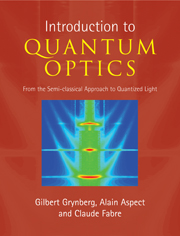Book contents
- Frontmatter
- Contents
- Foreword
- Preface
- Acknowledgements
- Part I Semi-classical description of matterlight interaction
- Part II Quantum description of light and its interaction with matter
- 4 Quantization of free radiation
- Complement 4A: Example of the classical Hamiltonian formalism: charged particle in an electromagnetic field
- Complement 4B: Momentum and angular momentum of radiation
- Complement 4C: Photons in modes other than travelling plane waves
- 5 Free quantum radiation
- Complement 5A: Squeezed states of light: the reduction of quantum fluctuations
- Complement 5B: One-photon wave packet
- Complement 5C: Polarization-entangled photons and violation of Bell's inequalities
- Complement 5D: Entangled two-mode states
- Complement 5E: Quantum information
- 6 Interaction of an atom with the quantized electromagnetic field
- Complement 6A: Hamiltonian formalism for interacting fields and charges
- Complement 6B: Cavity quantum electrodynamics
- Complement 6C: Polarization-entangled photon pairs emitted in an atomic radiative cascade
- Part III Applying both approaches
- Index
Complement 5E: Quantum information
Published online by Cambridge University Press: 05 August 2012
- Frontmatter
- Contents
- Foreword
- Preface
- Acknowledgements
- Part I Semi-classical description of matterlight interaction
- Part II Quantum description of light and its interaction with matter
- 4 Quantization of free radiation
- Complement 4A: Example of the classical Hamiltonian formalism: charged particle in an electromagnetic field
- Complement 4B: Momentum and angular momentum of radiation
- Complement 4C: Photons in modes other than travelling plane waves
- 5 Free quantum radiation
- Complement 5A: Squeezed states of light: the reduction of quantum fluctuations
- Complement 5B: One-photon wave packet
- Complement 5C: Polarization-entangled photons and violation of Bell's inequalities
- Complement 5D: Entangled two-mode states
- Complement 5E: Quantum information
- 6 Interaction of an atom with the quantized electromagnetic field
- Complement 6A: Hamiltonian formalism for interacting fields and charges
- Complement 6B: Cavity quantum electrodynamics
- Complement 6C: Polarization-entangled photon pairs emitted in an atomic radiative cascade
- Part III Applying both approaches
- Index
Summary
The work of John Bell in the mid 1960s and experiments carried out to test his famous inequalities in the following decades have led to a detailed re-examination of the concepts of quantum mechanics, and revealed the full importance of the notion of entanglement. This reconsideration helped to generate the new and extremely rich field of research known as quantum information in the 1980s. The guiding idea behind this field of activity is that, by exploiting the specific rules of quantum physics, one can conceive of new ways of calculating and communicating, in which the rules of play are no longer the well-known classical rules.
One can thus develop new methods of cryptography in which the message is protected by the basic principles of quantum mechanics, and new computation methods that can be exponentially more efficient than classical algorithms. Quantum information is not therefore a mere sideline for physics, but concerns information theory, algorithmics and the mathematics of complexity theory. This research has already led to proposals for new algorithms and new computation architectures based on quantum logic gates with no classical equivalent. Still on the fundamental level, the meeting of information theory and quantum mechanics which lies at the heart of quantum information has led to a very stimulating regeneration of the theoretical tools used on both sides.
- Type
- Chapter
- Information
- Introduction to Quantum OpticsFrom the Semi-classical Approach to Quantized Light, pp. 443 - 456Publisher: Cambridge University PressPrint publication year: 2010



